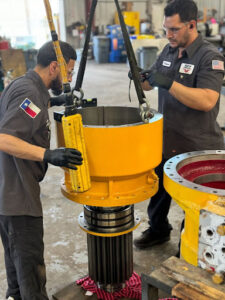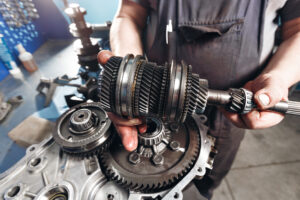1. Why Gearbox Maintenance Is Critical for Industrial Operations
Gearbox reliability is directly tied to plant productivity, asset utilization, and mechanical efficiency. A single unexpected failure can cascade into prolonged outages, missed production quotas, and a backlog of costly emergency interventions. Whether driving process-critical pumps, conveyors, or cooling tower fan drives, gearboxes are central to keeping your system running, yet they’re often neglected until gearbox failure symptoms are imminent.
Downtime is also a financial and operational liability. And while reactive repairs may offer a short-term fix, the long-term cost of deferred maintenance is almost always higher. That’s why forward-thinking maintenance managers are shifting focus toward proactive service strategies built around real diagnostics, root-cause analysis, and trusted service partners.
This article explores how proper gearbox maintenance, both preventive and predictive, can drastically reduce unplanned downtime. Drawing on insights from over 20 years of field experience at Houston Pump & Gear, we’ll walk through the most common failure triggers, technical strategies for early detection, and the critical role that specialized repair providers play in keeping mechanical systems running with confidence.
Benefits of Maintenance
Keeping your gearbox in peak condition is about protecting your entire operation. With the right inspection and maintenance practices, you not only extend the life of your equipment but also unlock measurable gains in efficiency, cost savings, and workplace safety.
- Extended equipment lifespan and increased ROI: Regular inspection and knowing how to service a gearbox keeps your assets in the field longer, reducing capex expenditures over time.
- Higher system efficiency: A well-maintained gearbox operates with less friction and stress on internal parts, improving mechanical output.
- Lower emergency repair costs: Identifying early wear and failure modes avoids last-minute breakdowns that require urgent intervention.
- Improved safety conditions: Proactive upkeep mitigates risks such as fluid leaks, overheating, or gear seizure that could endanger personnel.
When gearbox maintenance is neglected, the result is almost always the same: unplanned downtime, inflated costs, and unnecessary strain on maintenance teams.
2. Common Causes of Gearbox Downtime
Preventing downtime starts with knowing where it comes from. These are the most common culprits:
- Inadequate gearbox lubrication: Often the leading cause of gearbox failure, this includes using the wrong lubricant, skipping change intervals, or dealing with oil contamination.
- Misalignment: Poor alignment between shafts or gear components leads to uneven load distribution, generating excess heat and mechanical stress.
- Overheating: Often triggered by friction, overloading, or insufficient airflow, high temperatures degrade the lubricant and damage internal parts.
- Contamination: Particulates like dirt or water compromise the lubricant and abrade internal surfaces, accelerating gear and bearing wear.
- Wear and tear: All components wear out eventually. Without scheduled assessments, minor wear can escalate to catastrophic failure.
Need to reduce costly downtime? Let our gearbox experts
design a solution that keeps your plant running.
3. Proactive Strategies for Reducing Downtime
Houston Pump & Gear provides solid experience with facilities across North America implementing both preventive and predictive strategies that help maintain uptime and reduce the chaos of unplanned failures.
Preventive Maintenance
Preventive maintenance serves as the first line of defense. It begins with establishing a strict service schedule and consistently adhering to it. Regular inspections allow plant personnel to detect early warning signs (such as oil leaks, metal shavings in the lubricant, abnormal vibration patterns, or shifts in operating noise) that may indicate deeper internal issues.
Effective lubrication management is also critical. Following or exceeding OEM recommendations and switching to high-grade synthetic lubricants can reduce internal friction, minimize component stress, and extend both lubricant life and change intervals. Environmental control plays a role as well. Keeping gearboxes clean, sealed, and protected from contaminants significantly reduces the risk of particulate intrusion, seal failure, and accelerated wear.
Predictive Maintenance (For More Advanced Facilities)
Predictive maintenance leverages data-driven methods to identify issues before they lead to failure. Oil analysis, for example, involves laboratory testing of lubricant samples to detect the presence of contaminants, wear particles, and viscosity changes, offering valuable insights into internal wear conditions.
Vibration monitoring is another powerful tool. Using advanced sensors, this method captures real-time vibration signatures and identifies deviations that may indicate early-stage gear or bearing degradation. Thermal imaging further enhances predictive capabilities by highlighting abnormal heat patterns within the gearbox. These temperature anomalies often point to excessive friction, misalignment, or lubrication breakdown.
By integrating both preventive and predictive practices, you create a system that reacts before problems emerge.
Facing gearbox failure or urgent repair needs? Houston Pump &
Gear is ready 24/7 to get you back online fast.
4. The Role of a Professional Partner
While many plants perform basic inspections in-house, advanced diagnostics and major repairs require a deeper level of expertise. That’s where Houston Pump & Gear comes in.
With over 20 years of hands-on experience, Houston Pump & Gear is known for solving complex gearbox and pump challenges across critical industries. Our technicians bring deep field expertise, enabling fast diagnosis and repair to minimize downtime.
Our full-service model includes inspections, rebuilds, reverse engineering, and custom gear manufacturing, eliminating the delays of coordinating multiple vendors.
We respond fast with 24/7 emergency service for pump and gearbox failures. Every repair meets API specs and is backed by precision standards.
We also offer a Cooling Tower Gear Reducer Exchange Program to cut crane time and disruption, and we manufacture gear types up to 360” OD in-house for oversized or legacy systems.
What can proactive maintenance do for your bottom line?
Talk to our team today and build a smarter plan.
5. Frequently Asked Questions (FAQs)
How often should industrial gearboxes be serviced?
It varies depending on application and load profile. However, a good rule of thumb is to follow the manufacturer’s suggested gearbox maintenance schedule and conduct visual inspections quarterly, with a more thorough service annually.
What are the most common signs of a failing gearbox?
Listen for unusual noises (clunking, grinding), watch for excessive vibration, monitor temperature rises, and inspect for oil leaks. Any one of these could signal internal damage.
What is the difference between preventive and predictive maintenance?
Preventive maintenance is done on a schedule, like changing oil every 6 months. Predictive maintenance is based on real-time data (like vibration or oil analysis) to predict issues before they cause failure.




